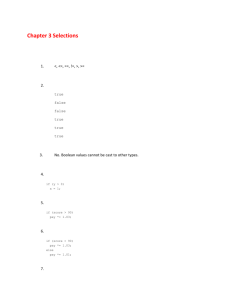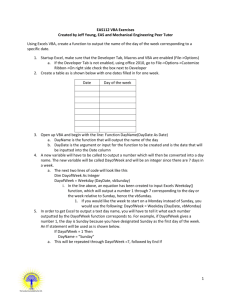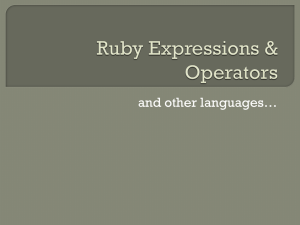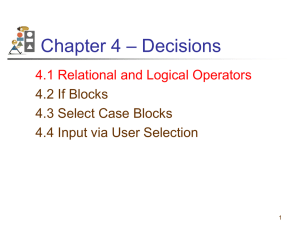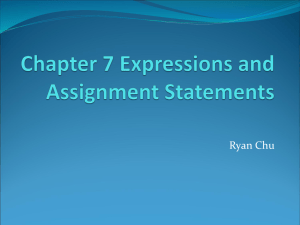if-else-switch-radiobuttons
advertisement
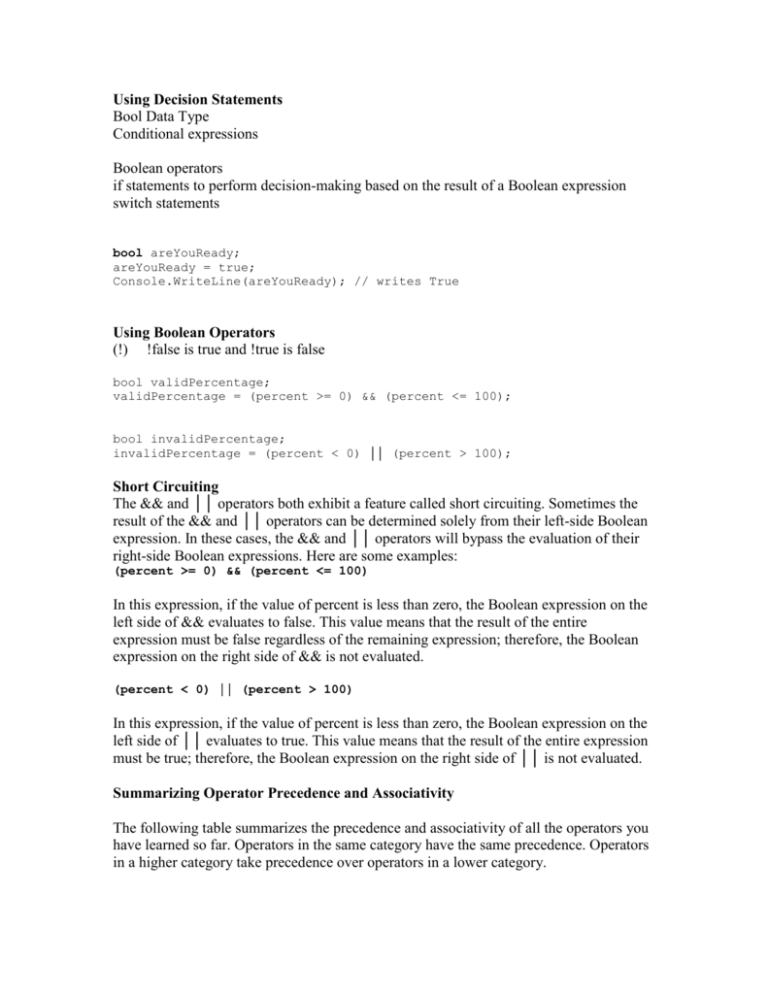
Using Decision Statements
Bool Data Type
Conditional expressions
Boolean operators
if statements to perform decision-making based on the result of a Boolean expression
switch statements
bool areYouReady;
areYouReady = true;
Console.WriteLine(areYouReady); // writes True
Using Boolean Operators
(!) !false is true and !true is false
bool validPercentage;
validPercentage = (percent >= 0) && (percent <= 100);
bool invalidPercentage;
invalidPercentage = (percent < 0) ││ (percent > 100);
Short Circuiting
The && and ││ operators both exhibit a feature called short circuiting. Sometimes the
result of the && and ││ operators can be determined solely from their left-side Boolean
expression. In these cases, the && and ││ operators will bypass the evaluation of their
right-side Boolean expressions. Here are some examples:
(percent >= 0) && (percent <= 100)
In this expression, if the value of percent is less than zero, the Boolean expression on the
left side of && evaluates to false. This value means that the result of the entire
expression must be false regardless of the remaining expression; therefore, the Boolean
expression on the right side of && is not evaluated.
(percent < 0) ││ (percent > 100)
In this expression, if the value of percent is less than zero, the Boolean expression on the
left side of ││ evaluates to true. This value means that the result of the entire expression
must be true; therefore, the Boolean expression on the right side of ││ is not evaluated.
Summarizing Operator Precedence and Associativity
The following table summarizes the precedence and associativity of all the operators you
have learned so far. Operators in the same category have the same precedence. Operators
in a higher category take precedence over operators in a lower category.
Category
Primary
Unary
Operators Description
()
Precedence override
!
NOT
*
Multiplicative /
Associativity
Left
Left
Multiply Divide Division remainder
Left
Addition Subtraction
Left
%
+
Additive
<
<=
Relational
>
Less than Less than or equal Greater than Greater
Left
than or equal
>=
==
Equality
Equal to Not equal to
Left
Logical AND Logical OR
Left
!=
&&
Boolean
Assignment
││
=
Right
Understanding if Statement Syntax
if ( booleanExpression )
statement-1
else
statement-2
int seconds;
if (seconds == 59)
seconds = 0;
else
seconds = seconds + 1;
Boolean Expressions Only Please!
The expression in an if statement must be enclosed in parentheses. Additionally, the
expression must be a Boolean expression. Some other languages (notably C and C++)
allow you to write an integer expression and silently convert the integer value to true
(nonzero) or false (zero). C# never does this silent conversion.
Also, if you're writing an if statement and you accidentally write an assignment instead of
an equality test, the C# compiler will recognize your mistake, for example:
int seconds;
if (seconds = 59)
// compile-time error
if (seconds == 59) // ok
Finally, you can use a Boolean variable as the expression, as in this example:
bool inWord;
if (inWord == true) // ok, but non-idiomatic
if (inWord)
// better
Cascading if Statements
if (day == 0)
dayName = "Sunday";
else if (day == 1)
dayName = "Monday";
else if (day == 2)
dayName = "Tuesday";
else if (day == 3)
dayName = "Wednesday";
else if (day == 4)
dayName = "Thursday";
else if (day == 5)
dayName = "Friday";
else if (day == 6)
dayName = "Saturday";
else
dayName = "unknown";
Ejemplo:
if (day == 0)
dayName = "Sunday";
else if (day == 1)
dayName = "Monday";
else if (day == 2)
dayName = "Tuesday";
else if (day == 3)
else
dayName = "Unknown";
Understanding switch Statement Syntax
The syntax of a switch statement is as follows (switch, case, and default are keywords):
switch ( controllingExpression )
{
case constantExpression :
statements
break;
case constantExpression :
statements
break;
default :
statements
break;
}
Ejemplo:
switch (day)
{
case 0 :
dayName = "Sunday";
break;
case 1 :
dayName = "Monday";
break;
case 2 :
dayName = "Tuesday";
break;
default :
dayName = "Unknown";
break;
}
Following the switch Statement Rules
The switch statements are very useful but, unfortunately, you can't always use them when
you might like to. Your switch statements must adhere to the following rules:
You can use switch only on primitive data types (such as int) and string. If you
need to use switch on any other types, you'll have to use an if statement.
Your case labels must be constant expressions, such as 42 or "42". If you need to
calculate your case label values at run time, you'll have to use an if statement.
Your case labels must be unique expressions. In other words, you're not allowed
to write two case labels with the same value.
switch (trumps)
{
case Hearts :
case Diamonds:
color = "Red";
break;
case Clubs :
case Spades :
color = "Black";
break;
}
No Fall-Through
Demostración de uso de:
Groupbox
Radiobottons
Eventos Click y CheckedChanged
Ejercicio de práctica:
Crear una interface para calcular el costo de las comisetas dependiendo del tamano y del
número de camisetas.
